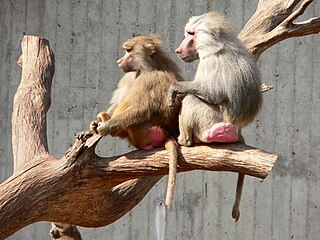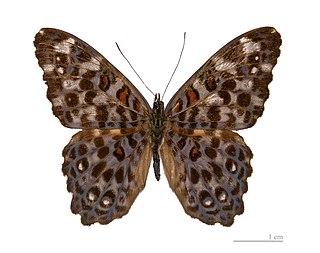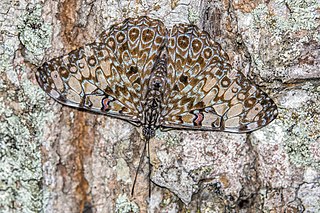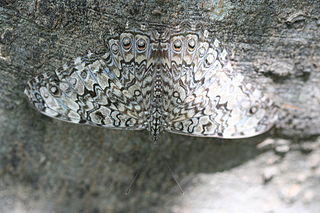
A hamadryad or hamadryas is a Greek mythological being that lives in trees. It is a particular type of dryad which, in turn, is a particular type of nymph. Hamadryads are born bonded to a certain tree on which its life depends. Some maintain that a hamadryad is the tree itself, with a normal dryad being simply the indwelling entity, or spirit, of the tree. If the tree should die, the hamadryad associated with it would die as well. For this reason, both dryads and the other gods would punish mortals who harmed trees.

Nausicaa, also spelled Nausicaä or Nausikaa, is a character in Homer's Odyssey. She is the daughter of King Alcinous and Queen Arete of Phaeacia. Her name means "burner of ships".

In Greek mythology, Queen Arete of Scheria was the wife of Alcinous and mother of Nausicaa and Laodamas.

Arete is a concept in ancient Greek thought that, in its most basic sense, refers to "excellence" of any kind—especially a person or thing's "full realization of potential or inherent function." The term may also refer to excellence in "moral virtue."

An arête is a narrow ridge of rock that separates two valleys. It is typically formed when two glaciers erode parallel U-shaped valleys. Arêtes can also form when two glacial cirques erode headwards towards one another, although frequently this results in a saddle-shaped pass, called a col. The edge is then sharpened by freeze-thaw weathering, and the slope on either side of the arête steepened through mass wasting events and the erosion of exposed, unstable rock. The word arête is actually French for "edge" or "ridge"; similar features in the Alps are often described with the German equivalent term Grat.

The hamadryas baboon is a species of baboon within the Old World monkey family. It is the northernmost of all the baboons, being native to the Horn of Africa and the southwestern region of the Arabian Peninsula. These regions provide habitats with the advantage for this species of fewer natural predators than central or southern Africa where other baboons reside. The hamadryas baboon was a sacred animal to the ancient Egyptians and appears in various roles in ancient Egyptian religion, hence its alternative name of 'sacred baboon'.

The Guinea baboon is a baboon from the Old World monkey family. Some (older) classifications list only two species in the genus Papio, this one and the hamadryas baboon. In those classifications, all other Papio species are considered subspecies of P. papio and the species is called the savanna baboon.
Hamadryas was a nymph, the mother of the hamadryads in Greek mythology, and the name has been used repeatedly in scientific naming and may refer to:

Arete of Cyrene was a Cyrenaic philosopher who lived in Cyrene, Libya. She was the daughter of Aristippus of Cyrene.

Cracker butterflies are a Neotropical group of medium-sized brush-footed butterfly species of the genus Hamadryas. They acquired their common name due to the unusual way that males produce a "cracking" sound as part of their territorial displays. The most comprehensive work about their ecology and behavior is that of Julian Monge Najera et al. (1998). The genus was erected by Jacob Hübner in 1806.

Kakia is the Greek goddess of vice and moral badness, abominations. She was depicted as a vain, plump, and heavily made-up woman dressed in revealing clothes, and was presented as the opposite of Areté, goddess of excellence and virtue.

Tellervini is a tribe of danaid butterflies with only the one genus Tellervo, with six widely distributed species found in the Australasian realm and the Indomalayan realm. The taxon is apparently monophyletic, but its relationship with the other two danaid tribes is yet uncertain. The phylogeography of the group is also a challenge to those who hold to a Cenozoic origin of the butterflies.

Baboons are primates comprising the genus Papio, one of the 23 genera of Old World monkeys, in the family Cercopithecidae. There are six species of baboon: the hamadryas baboon, the Guinea baboon, the olive baboon, the yellow baboon, the Kinda baboon and the chacma baboon. Each species is native to one of six areas of Africa and the hamadryas baboon is also native to part of the Arabian Peninsula. Baboons are among the largest non-hominoid primates and have existed for at least two million years.

Princess Arete is a 2001 Japanese animated film written and directed by Sunao Katabuchi, animated and produced by Studio 4°C and distributed by Omega Entertainment. It is based on Diana Coles's 1983 book The Clever Princess. The film is a non-traditional approach to the standard tales of fairy tale princesses, and it is known in Japan as one of the most successful animated feminist works.

Hamadryas amphinome, the red cracker, is a species of cracker butterfly in the family Nymphalidae, native to regions of North and South America.

Hamadryas chloe, the Chloe cracker, is a species of cracker butterfly in the family Nymphalidae. It is found in Suriname, Peru, Colombia, Bolivia, and Brazil.

Hamadryas feronia, the blue cracker or variable cracker, is a species of cracker butterfly in the family Nymphalidae. It is found in the southern parts of North America and South America and southwards Brazil.
Homonoia, ( in ancient Greek religion, was a minor goddess of concord, unanimity, and oneness of mind. Her opposite was Eris.

Hamadryas februa, the graycracker, is a species of cracker butterfly in the family Nymphalidae. It is found from Argentina north through tropical America to Mexico. Rare strays can be found up to the lower Rio Grande Valley in southern Texas. The habitat consists of subtropical forests, forest edges and cultivated areas with trees.

Hamadryas is a genus of flowering, perennial herbs in the family Ranunculaceae. It is found in the southernmost regions of Chile and Argentina, as well as the Falkland Islands, predominantly in alpine and sub-alpine habitats. The range of one species, Hamadryas delfinii, extends north into San Juan Province, Argentina.

















